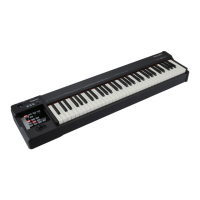Panel Descriptions
5
D-BEAM controller
Moving your hand to apply various eects to the sound
To turn on the D-BEAM controller, press the button so it’s lit.
Button Function
[PITCH] The pitch will change as you move your hand above the D-BEAM controller.
[VOL] The volume will change, allowing you to add expression to your performance.
[ASSIGN] The aftertouch eect will be applied.
OCTAVE [−], [+], [TRANSPOSE] button
Changing the octave (Octave Shift)
You can raise or lower the pitch range of the keyboard (Octave Shift) by using the [+] [–] buttons.
• You can change this setting in the range of -4 to 5 octaves.
• If you press the [+] button and [–] button simultaneously, this setting will be reset to 0.
Changing the pitch (Transpose)
You can transpose the pitch in semitone step by using the [+] [–] buttons while holding down the
[TRANSPOSE] button.
• You can change this setting in the range of -6 to 5.
• When the [TRANSPOSE] button is turned on, the transposition setting is enabled. When the [TRANSPOSE]
button is turned o, the transposition setting is disabled.
• If you press the [TRANSPOSE] button, the [+] button, and the [–] button simultaneously, this setting will be
reset to 0.
[REVERB] button
Adding reverberation to the sound (Reverb)
By pressing the [REVERB] button so it’s lit, you can apply a reverb eect (reverberation) to the sound you’re playing from the keyboard.
Applying the reverb eect will produce the spacious ambience that is typically heard when performing in a concert hall.
* You cannot adjust the amount of the reverb eect.
EQ [LOW], [HIGH] knob
Adjusting the upper and lower ranges (Equalizer)
The RD-64 is equipped with a two-band equalizer.
You can adjust the level of the low-frequency range and high-frequency range for each tone.
* The equalizer settings are stored (Hold down the [SuperNATURAL] button, and press [A. PIANO] and [ORGAN] buttons simultaneously to store all 12 tones).
[EFX 1], [EFX 2] button
Applying eects to the sound
By pressing the [EFX 1] or [EFX 2] button so it’s lit, you can apply an eect to the sound you’re playing from the keyboard.
The following eects are applied for each tone group.
For details of each eects, refer to “Eect List” (p. 13)
* The on/o statuses of [EFX 1] and [EFX 2] are stored (Hold down the [SuperNATURAL] button, and press [A. PIANO] and [ORGAN] buttons simultaneously to store all 12
tones).
Group EFX 1 EFX 2
A. PIANO ENHANCER DAMPER RESONANCE
E. PIANO TREMOLO PHASER
CLAV AUTO WAH OVERDRIVE
ORGAN ROTARY SPEED
Eective range of the D-BEAM
controller
This illustration shows the
eective range of the D-BEAM
controller. No eect will be
obtained if you position your
hand outside the eective
range.
* The eective range of the
D-BEAM controller will
change depending on the lighting conditions.
-6
Unlit Lit
-5 -4 -3 -2 -1 0 1 2 3 4 5
Indicator and the setting it shows

